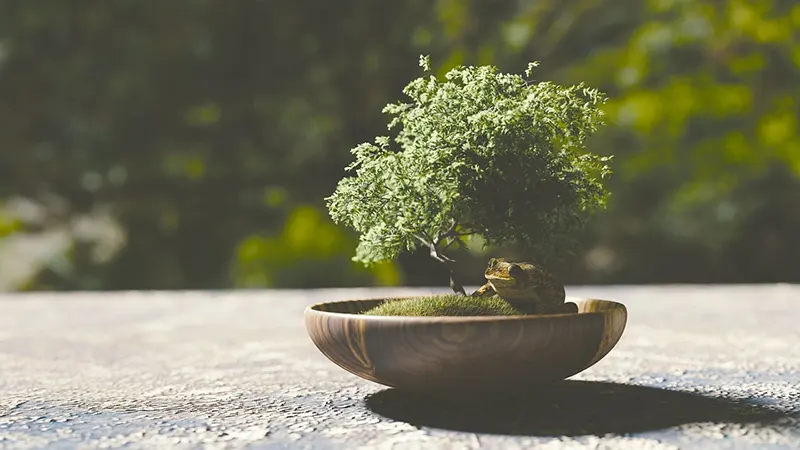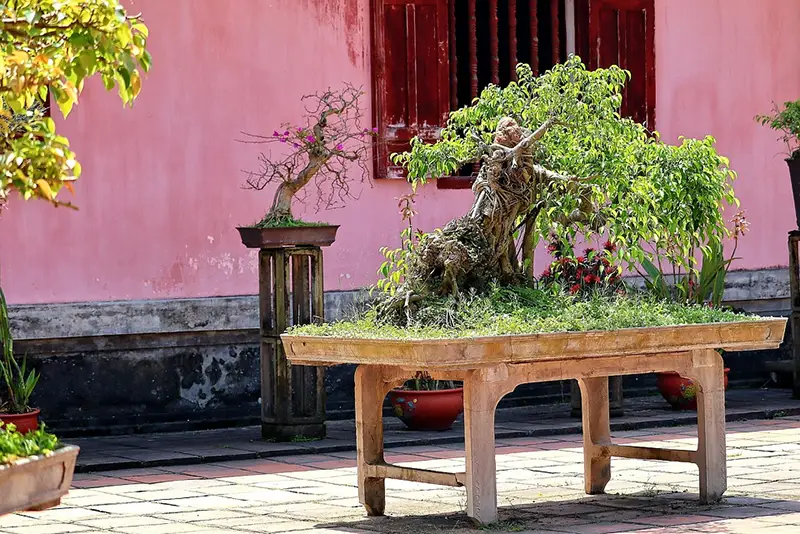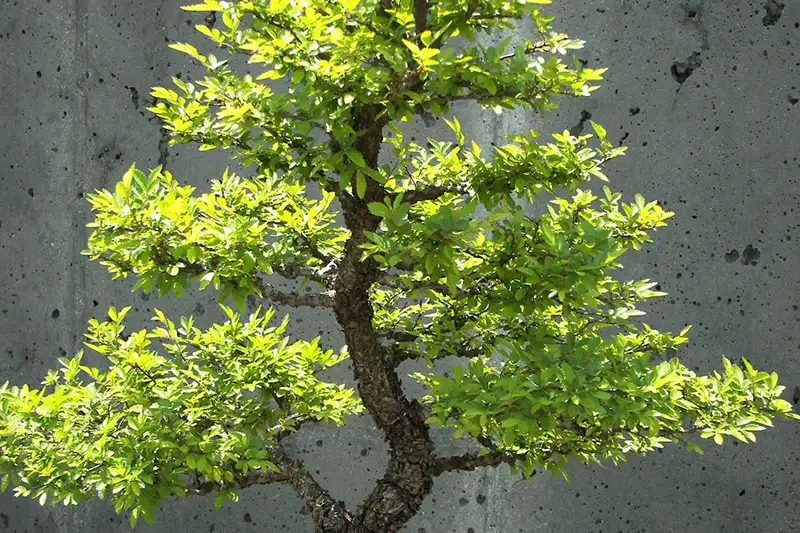Outdoor Bonsai Tree Care Guide
One of the top questions most beginners have about bonsais is whether they should keep them indoors or outdoors. Not all trees can handle being out in the sun for long periods, which is when you’ll need to grow them outside. However, you do find species that thrive out in nature, ready to soak up the light.
If you do decide to grow an outdoor bonsai tree, there are several things you need to keep in mind. While the trees in the wild usually do well on their own, these smaller versions will need extra care and protection.
Deciding Where to Place Your Bonsai Tree - Indoor or Outdoor?
When we talk about an outdoor bonsai tree, we aren’t only referring to placing it in the garden. There are different situations you may have at home. For example, you may have an outside balcony attached to your apartment. For the office workers, there may be a wide windowsill where you can put the pot on the other side of the glass.
It also includes any patio where you have a covering but no walls to shield the bonsais from the elements. No matter which scenario you have, you’ll need to provide protection so that the trees can remain healthy and strong.
The Dangers of the Seasons
Before we show you how to care for your outdoor bonsai tree, it’s essential that you understand the dangers they’ll encounter in every season. We’re not trying to discourage you from keeping them outside. We just want you to recognize the risks so that you can take the necessary steps where appropriate.
Here’s a look at the different seasons and the possible dangers to your outdoor bonsai:
- Spring: The frost is vanishing, and new buds start to appear. If you’ve had your bonsai indoors during the winter, don’t bring them out too soon. They may not be ready for such a quick transition. Watch out for a rise in insects and pests.
- Summer: In hot climates, the afternoon sun’s light and heat can severely damage leaves. Arid regions also have low humidity, which can be devastating to some bonsai species. High temperatures are also dangerous.
- Autumn: With the light diminishing, you’ll need to check the position of your bonsai tree outside. Also, the lowering temperatures and rising cold may see some mold and other fungi appear at this time.
- Winter: If you live in an area that receives intense frost, the cold may kill parts of your bonsai tree on the inside where you can’t see it. You’ll either need to provide a warm shelter or bring them indoors.

Steps to Outdoor Bonsai Tree Care
Now that you have a better idea of what to look out for when you place your bonsai tree outside, here are the steps to caring for it during any season. You’ll need to make some slight adjustments based on the species, but we’re sure you’ll get the hang of it.
You can also check our detailed bonsai tree care guide for more information.
Step 1: Sufficient Light
Bonsai trees thrive outdoors when they receive enough sunlight during the day. Most species are satisfied with about four to six hours of morning light, but they’re happy with a bit more in the evening. The trick is finding a location that provides the light while protecting them with shade in the peak afternoon.
The summer is extremely harsh on the miniature trees that you place outside. The noon sun is incredibly close to the earth at that point, and the heat and light can burn fragile leaves. While it’s not efficient to move your bonsais around every season, you may need to do so if you don’t have a proper plan in place.
Step 2: Humidity
Dry and hot regions suffer from low humidity, which is something that doesn’t bode well for your outdoor bonsai tree. Most species prefer high moisture in the air, preferably above 50%, while more than 60% is preferred. Of course, you’ll need to make sure the dampness doesn’t cause mold to form.
To increase humidity, you can use a bonsai humidity tray. The sun evaporates the water from the pebbles, which turns into vapor that rises to the leaves. It works better than a spray bottle. Another option is watering the walls and floor around your bonsais with your hose pipe, releasing more water molecules into the air.
Step 3: Watering and Feeding
Two of the essential elements you’ll need to adjust per season are watering and feeding. You’ll need to get up early in spring and summer to provide both nutrients, preferably before the sun strikes them. It gives the bonsai trees chance to drink and feed before photosynthesis kicks into play, making sure they have enough energy for the process.
When autumn arrives, you’ll need to judge how much water and food your outdoor bonsai tree needs. If you receive more rain during this time, you won’t need to worry too much about manual watering. Just keep an eye on the soil to make sure there’s sufficient drainage.
Winter is the killer season. Whether you have evergreen or deciduous bonsai trees, they’ll usually go dormant during this period. If you have excessive rain, you need to check the soil for any signs of rotting or disease. It may be a better idea to bring them inside.
Step 4: Temperatures
While most trees can handle any temperature in the wild, bonsai trees that you keep outdoors aren’t so lucky. Some species don’t do too well in hot climates, especially when there’s a lack of water and humidity. You’ll need to look for drought-tolerant plants if you want them to do well in that region.
The same rule applies to cold zones. If the temperature drops too low outside for too long, it can cause the bonsai to die. You’ll have a better chance with species that are known to survive frost. Once again, bring the small trees inside to keep them warm until spring.
Step 5: Elemental Dangers
Most of the above steps already cover some elemental dangers, but there are more you should be aware of. Strong winds can topple your bonsai tree if they have no protection outside. You can make a small shelter to use walls to make sure they don’t blow over.
Another factor most bonsai beginners don’t consider is the presence of a pet or wild animals. Cats love to investigate plants, but there are others that may come to have a look. If you don’t want them to knock over your precious babies, be sure to secure them to the table or support structure.
Of course, you’re increasing the chances of insects and pests infecting your bonsai trees when you put them outside. You may need to take measures to protect them from these villains. Some worms can be good for airing the soil, but watch out for ones that eat the leaves or branches.
Factors to Consider when Selecting an Outdoor Bonsai Tree
As if the above considerations weren’t enough, we have a few more factors you need to keep in mind when buying an outdoor bonsai tree. These will help when you’re at the store or shopping online, wondering if taking one is such a good idea.
Local Climate
As mentioned before, the climate plays a role in how intense the temperature, humidity, and strong winds are. A helpful way to evaluate which bonsai you can place outdoors is by looking at the hardiness zone for that species. If you live outside those regions, we suggest you hunt for a different tree.
Garden or Balcony Conditions
Balconies and gardens can assist you with the steps we mentioned above, depending on where you put the bonsai. You can use walls and covers to protect against the elements, while hedges and bushes can do the same thing. Also, there tends to be high humidity around walls and other trees, so design a lovely grove with the bonsai in the middle for maximum effect.
Personal Preference
While all of these factors are important, it also comes down to your taste. We understand how it feels to want a flowering bonsai, or perhaps you want a small tree with fruit. There are so many different types of bonsais, and you should look at the ones that will make you the happiest. After all, it will be your companion for several years. Don’t settle for less.
Design Options
You’ll be surprised how much of a role design has to play in your decision for an outdoor bonsai tree. When you have shelves and stands ready to display them, you’ll want to make sure they have the properties to match the theme you’re going for. For example, if you have plenty of greenery, you can aim for evergreens or conifers. Are there loads of color? Aim for flowering bonsais with hues to match.
Species and Compatibility
We’ve indicated before how essential it is that you research the bonsai species you want to place outside. They need to be compatible with the specific location, whether you want to put them in your garden, patio, balcony, or any other area. So, if you’ve decided you want a flowering tree, check which species have stunning flowers that will survive in that area.
Which Bonsai Species are Ideal for Placing Outside
As a special treat, we’ll save you some time and show you which bonsai trees we recommend you grow outdoors. They’re most suitable for open spaces in your garden, but you can place them anywhere outside. Here are our top picks.
Juniper
The Juniper bonsai is a classic tree that many growers develop outside. As a matter of fact, we highly recommend it as one of the top species for your garden. It needs as much sunlight as it can get during the day, and it can even survive harsh summers. You’ll just need to watch out for frost in the winter, as it can only handle so much exposure to cold climates. It’s mostly known for being easy to develop as a cascade bonsai.
Pyracantha
Say hello to the Firethorn. It’s an exceptional outdoor bonsai tree that even loves the winter. It does so well in the cold seasons that you’ll see fruit with different colors, depending on the subspecies or cultivar. We love the ones with red fruit, as it gives the small tree a flaming appearance.
Hinoki Cypress
While the Hikoki Cypress doesn’t grow tall, you’ll love how the branches spread to the side. If you have enough space, you can let them extend as far as you want, making it the highlight of the show. It’s ideal for outdoor gardens, but you can also place them on your balcony.
Italian Cypress
If you’re looking for an upright, slender outdoor bonsai tree that tapers to the top, you can’t go wrong with an Italian Cypress. The dark green needles soak in the sun at every opportunity, rising higher to gain as much of it as possible. The seed pods are absolutely beautiful, and it’s so easy to propagate more with the seeds.
Camellia Sasanqua
Also known as the Japanese or Chinese Camellia, the bonsai showcases a lovely flower that looks like a rose. It has deep green leaves that are stunning to view, while it remains hardy in hot and cold climates. They represent long life and health, and are ideal for patios or gardens. Pruning camellias and keeping them in shape is incredibly easy.
Ficus
There are so many ficus bonsai trees you can buy online. The genus is full of popular species, and you’ll see many of them at your local plant store. The main reason they’re so abundant is that they’re excellent choices for beginners due to their hardiness. Even if you forget to water them for a few days, they’ll survive until you come back with loving care.
Colorado Blue Spruce
Americans will quickly recognize the Colorado Blue Spruce for how popular it is in the United States. It looks like a Christmas tree, so many people decorate their small bonsais during the festive season. They thrive under most conditions and are even suitable for cold climates where there’s snow. Just make sure that the tiny branches don’t suffer from the frost.
Crassula
The Crassula bonsai is one of our personal favorites. Not only do we have some in our garden, but it’s given us so many offcuts as babies that grow so fast. They’re succulents, which means they’re ideal as outdoor bonsai trees. They don’t need a lot of watering, even in the dead of summer. The small white flowers are also beautiful to behold in the shimmering sunshine. They’re also stunning when grown as a bonsai forest.
Jade Tree
Here’s another succulent bonsai tree that loves being outdoors. The only danger is watering it too much, which can cause the soft branches to swell and break. They have edible, oval leaves, while you’ll have a stunning display of flowers in the summer. In some countries, you see so many of them in the wild that they’re considered weeds.
Azalea
A hardy bonsai in drought-like conditions, the Azalea has plenty of species with gorgeous flowers. Even if you don’t have any shade, it will do well in the glory of the sunshine. When it’s too hot, some of the leaves may burn, though. It can live without water for a week, by which time you can give it a lovely deep soak in a tub.
Bougainvillea
The Bougainvillea is another genus of flowering bonsais that love being outdoors. They have thorns on the stem, so you’ll need to be careful when handling them. They don’t like too much watering, but they’ll still do well if there’s plenty of rain. Just make sure you have proper drainage covered so the roots can dry. Under the right conditions, they’ll develop colorful bracts around the flowers.
Myrtle
The final genus on our list is Myrtle. You may have noticed these trees growing in arid conditions, even when there isn’t much rainfall. Depending on the species, the leaves display a lovely assortment for most of the year. You can also develop a myrtle topiary to complement your bonsai in the garden.
Preparing to Move Your Bonsai Tree Outside
There are two scenarios where you’ll want to move your bonsai tree outdoors. The first is when the winter is over, and you’re moving into the warmth of spring. The second is when you discover your bonsai isn’t doing so well inside, so you think it will do better outside.
A common mistake beginners make is simply moving them outside permanently without some preparation. If you’d had them indoors for a few months, the trees need to become accustomed to the outside environment first. Should you simply move it outside and leave it there for the first few weeks, you’ll notice leaves dropping, and it may die.
It helps if you move the bonsai trees outdoors for a few hours of the day before bringing them back inside. Do this for about three to four weeks, and then you can leave them outside without any concern. You may see some leaves fall, but the tree may simply be shedding the old ones for new shoots.
Final Thoughts
Looking after an outdoor bonsai tree is easy when you know all that it entails. Under the right conditions, they’ll thrive and develop healthy shoots and flowers. However, they can just as easily die if you don’t look after them properly. We hope this guide has helped in some way.
FAQs about Outdoor Bonsai Trees
Before you leave, we discovered some questions people usually ask about the topic. We decided to use our expertise to answer as many of them as possible. Of course, you can contact us if there’s anything else you need to know.
Yes, they absolutely can. You’ll need a species that can tolerate various conditions, while you’ll also have to put some protective measures in place. They mimic trees growing in the wild, which are born to thrive in outside conditions. Just watch out for the frost in winter and ensure you water and feed the bonsai correctly.
There are several bonsai species that are suitable for living outdoors. A few examples include Juniper, Ficus, Bougainvillea, Azalea, Italian Cypress and Firethorn. There are many more, so make sure you do proper research on each one to see which one is ideal for your hardiness zone.
Many bonsai trees love being outdoors because of the rain. Even if you have hard rainfall for a few days, they’ll soak it up and enjoy the water. You need to ensure that there’s enough drainage so the soil doesn’t hold the moisture for too long, leading to root rot and other fungal diseases.
Sunlight helps bonsai trees make food, which is an essential form of survival. When placed outside, they receive several hours of light, which gives them the energy to grow. However, there is a thing such as too much sunlight, damaging the leaves and internal cells. It’s best to only provide up to six hours per day.
When the winter frost arrives, some species don’t like the intense cold. In times like this, you may want to bring your outdoor bonsai tree inside. As long as you place them by a window that delivers enough sunlight during the day, they should survive without too many complications. Just keep an eye out for the formation of mold or pest infestations.







